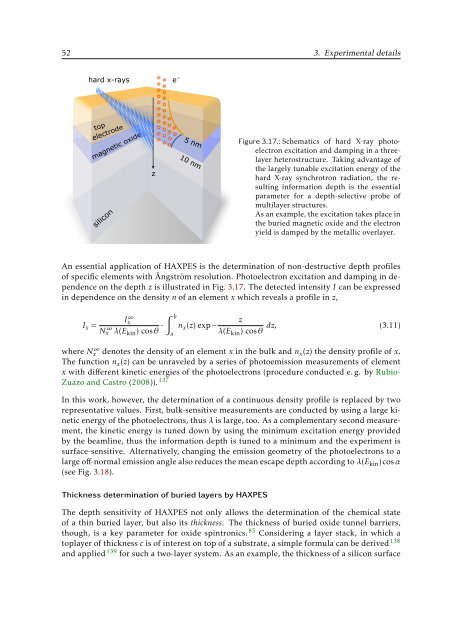Text anzeigen (PDF) - Universität Duisburg-Essen
Text anzeigen (PDF) - Universität Duisburg-Essen
Text anzeigen (PDF) - Universität Duisburg-Essen
You also want an ePaper? Increase the reach of your titles
YUMPU automatically turns print PDFs into web optimized ePapers that Google loves.
52 3. Experimental details<br />
hard x-rays<br />
e −<br />
z<br />
5 nm<br />
10 nm<br />
Figure 3.17.: Schematics of hard X-ray photoelectron<br />
excitation and damping in a threelayer<br />
heterostructure. Taking advantage of<br />
the largely tunable excitation energy of the<br />
hard X-ray synchrotron radiation, the resulting<br />
information depth is the essential<br />
parameter for a depth-selective probe of<br />
multilayer structures.<br />
As an example, the excitation takes place in<br />
the buried magnetic oxide and the electron<br />
yield is damped by the metallic overlayer.<br />
An essential application of HAXPES is the determination of non-destructive depth profiles<br />
of specific elements with Ångström resolution. Photoelectron excitation and damping in dependence<br />
on the depth z is illustrated in Fig. 3.17. The detected intensity I can be expressed<br />
in dependence on the density n of an element x which reveals a profile in z,<br />
I ∞ ∫ b<br />
x<br />
I x =<br />
Nx ∞ λ(E kin ) cosθ ·<br />
z<br />
n x (z) exp−<br />
a<br />
λ(E kin ) cosθ<br />
dz, (3.11)<br />
where N ∞ x denotes the density of an element x in the bulk and n x (z) the density profile of x.<br />
The function n x (z) can be unraveled by a series of photoemission measurements of element<br />
x with different kinetic energies of the photoelectrons (procedure conducted e. g. by Rubio-<br />
Zuazo and Castro (2008)). 137<br />
In this work, however, the determination of a continuous density profile is replaced by two<br />
representative values. First, bulk-sensitive measurements are conducted by using a large kinetic<br />
energy of the photoelectrons, thus λ is large, too. As a complementary second measurement,<br />
the kinetic energy is tuned down by using the minimum excitation energy provided<br />
by the beamline, thus the information depth is tuned to a minimum and the experiment is<br />
surface-sensitive. Alternatively, changing the emission geometry of the photoelectrons to a<br />
large off-normal emission angle also reduces the mean escape depth according to λ(E kin )cosα<br />
(see Fig. 3.18).<br />
Thickness determination of buried layers by HAXPES<br />
The depth sensitivity of HAXPES not only allows the determination of the chemical state<br />
of a thin buried layer, but also its thickness. The thickness of buried oxide tunnel barriers,<br />
though, is a key parameter for oxide spintronics. 85 Considering a layer stack, in which a<br />
toplayer of thickness c is of interest on top of a substrate, a simple formula can be derived 138<br />
and applied 139 for such a two-layer system. As an example, the thickness of a silicon surface
















